The Art of Creating Stunning Fall Planters
As summer’s riot of color whispers its goodbyes, the garden doesn’t have to fall silent. It can learn a new, more profound language—one of rich texture, moody hues, and enduring structure. This is the art of the fall planter, a composition that captures the fleeting, burnished beauty of the season and holds its ground against the coming chill. Forget fleeting trends; we are creating living sculptures for the autumn landscape.

Redefining the Fall Planter
Your outdoor containers can become living sculptures. They can capture autumn’s complex personality—warm afternoons giving way to crisp evenings, the last burst of growth before winter’s rest. And they can do it with style.
We’re talking about architectural form meeting tactile interest. Planters that work equally well beside your garage door or as standalone garden features. Designs that don’t just survive the transition from September to December—they celebrate it.
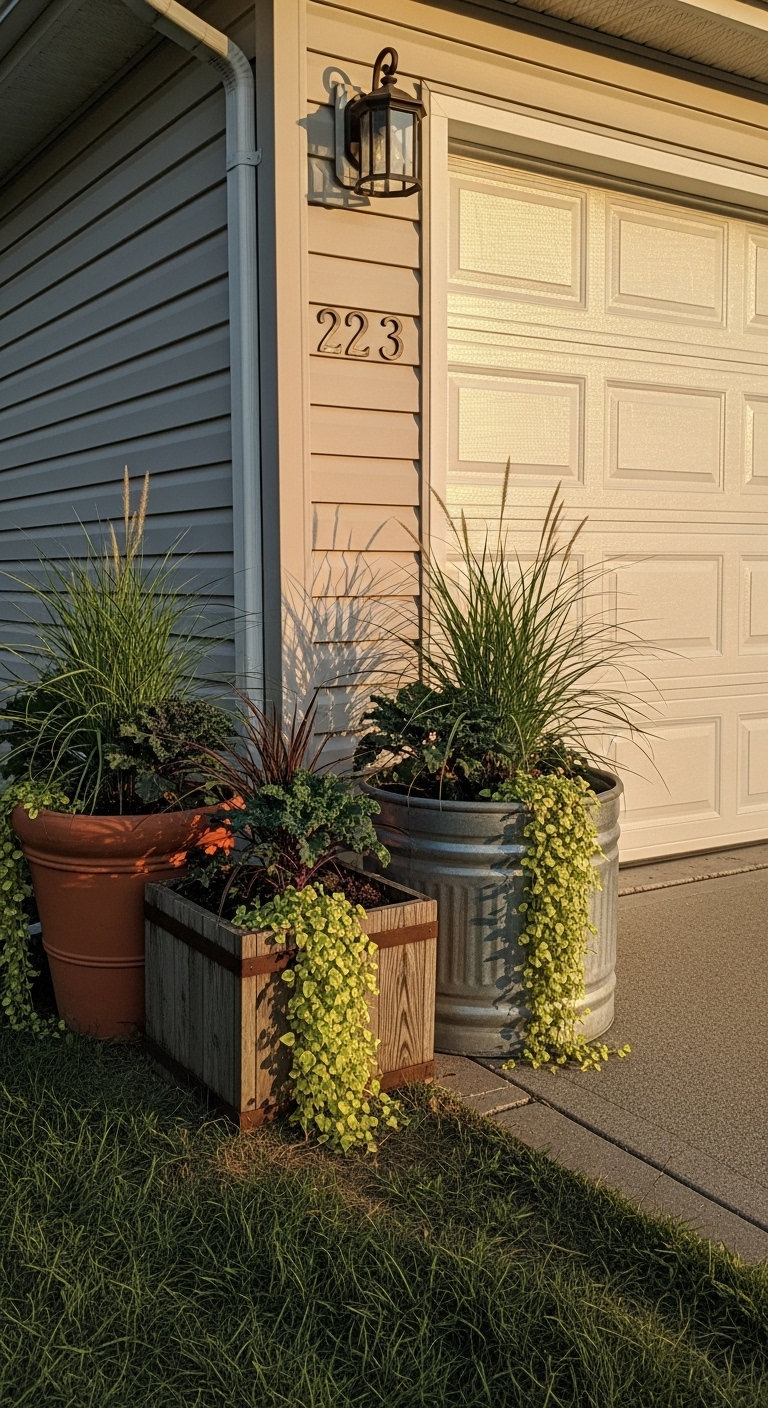
The Core Ethos: Capturing Seasonal Transition
Essence
The perfect fall planter isn’t summer’s last gasp. And it’s not winter’s early arrival either. It lives in that magical space between—embodying autumn’s unique character.
Think about what makes fall special. The warmth of afternoon sun on your face. The sharp bite of evening air. Gardens heavy with harvest. Plants gracefully accepting their seasonal fate.
Your containers should capture all of that.
Core Principles
Structure over Spectacle matters most. Choose plants with strong shapes and forms. They’ll look good even after frost turns everything crispy. A single ornamental grass can carry more visual weight than a dozen wilting flowers.
Texture becomes your new best friend. Smooth leaves next to fuzzy ones. Delicate fronds beside sturdy stems. Shiny surfaces contrasting with matte finishes. Mix these elements and watch your planters come alive.
Endurance and Grace guide your plant choices. Some plants hold their color through cold snaps. Others fade beautifully, turning into rustic sculptures. Both have value in fall containers.
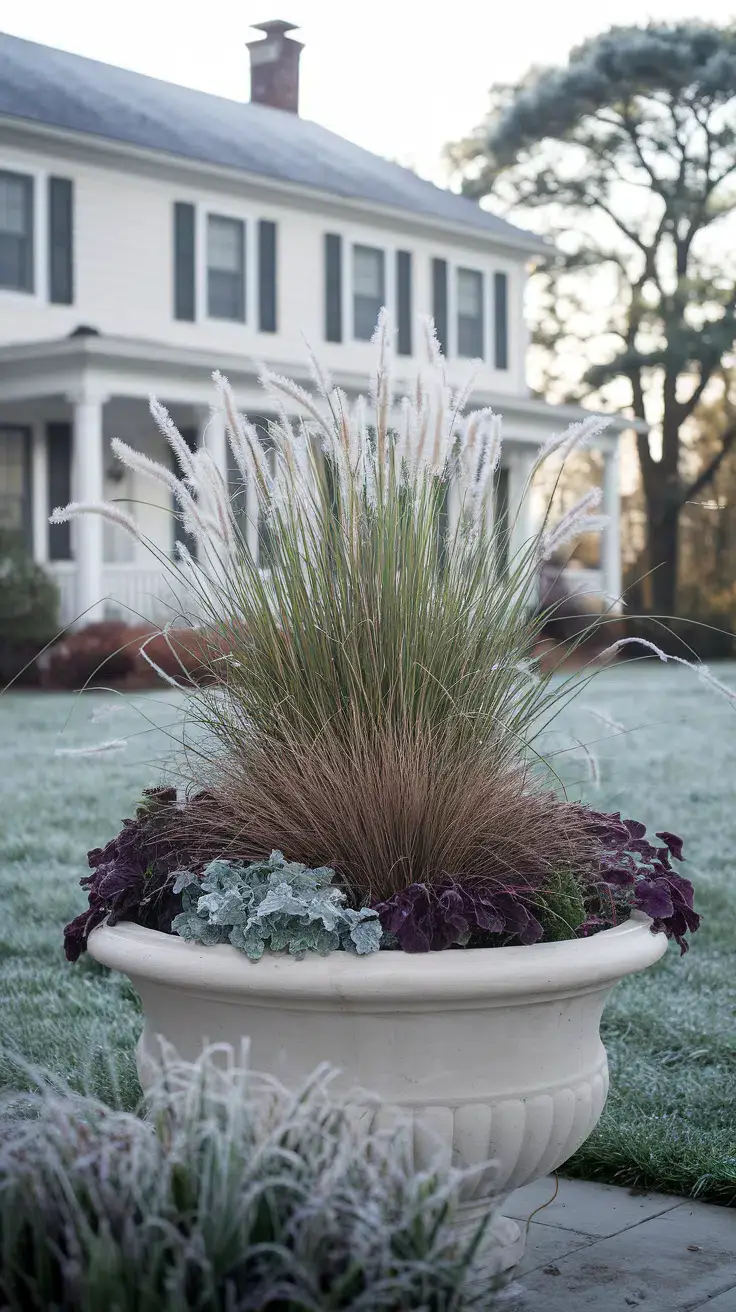
Deconstructing the Masterpiece: The “Tapestry” Method
Rethinking “Thriller, Filler, Spiller”
Everyone knows the thriller-filler-spiller formula. But let’s evolve it into something more sophisticated. Call it the “Tapestry” approach—weaving elements together for an integrated, natural look.
The Anchor replaces your thriller. But we’re not talking about a simple spike of dracaena anymore. Think bronze fennel swaying in the breeze. Or purple fountain grass creating movement and sound. These plants provide backbone while adding sensory interest.
The Weave takes over for fillers. Mid-level plants knit your composition together. But instead of just plugging holes, they create conversations between textures and colors. Ornamental cabbage plays off silvery dusty miller. Dark heuchera makes bright mums pop even more.
The Cascade softens harsh container edges. Sweet potato vine remains a classic choice. But consider red creeping thyme or silver dichondra for unexpected elegance.
Choosing Your Vessel
Your container choice sets the entire tone. Material matters more than you might think.
Terracotta breathes, keeping roots healthy. But it can crack in freeze-thaw cycles. Fiberstone offers terracotta’s look with better durability. Metal containers add modern edge but can overheat roots on sunny days. Wood brings rustic charm and insulates well against temperature swings.
Scale changes everything. Large fall containers planters make bold statements flanking doorways. Clustered smaller pots create intimate vignettes. Fall planter boxes by a garage can soften harsh architectural lines.

Sophisticated & Fresh Plant Palettes
Palette 1: Burnished Bronze & Deep Burgundy
Start with bronze fennel as your anchor. Its feathery foliage catches light like spun copper. Or try ‘Fireworks’ pennisetum grass—each blade tipped with burgundy brushstrokes.
Weave in ‘Palace Purple’ heuchera for depth. Its leaves look almost black in shade, wine-red in sun. Add dark-leafed fall planters with cabbage—not the boring green kind, but varieties like ‘Redbor’ with frilly purple edges. Bronze-toned fall planters mums complete the middle layer without screaming “grocery store display.”
Let ‘Blackie’ sweet potato vine cascade over edges. Its near-black leaves create drama. Red creeping thyme offers a subtler option, spilling gently while adding tiny flowers.
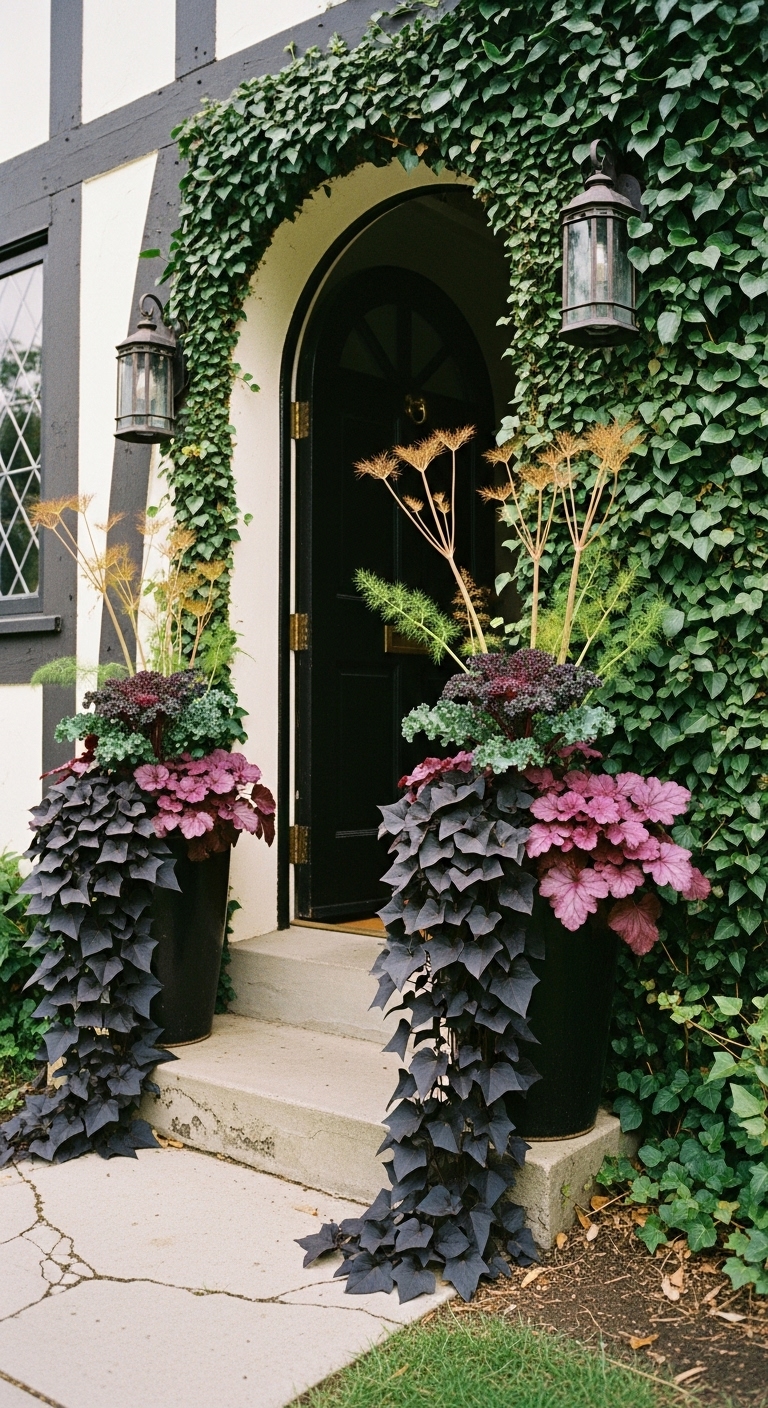
Palette 2: Harvest Moon Glow
‘Karl Foerster’ grass stands soldier-straight as your anchor. Its wheat-colored plumes glow in autumn light. Slender hinoki cypress adds evergreen structure that lasts through winter.
Build your weave with dusty miller’s silvery leaves. They look like velvet touched by moonlight. Cream-colored mums echo the grass plumes. Variegated sage brings subtle purple undertones and herbal fragrance.
Dichondra ‘Silver Falls’ creates a waterfall effect over container edges. Creeping jenny offers chartreuse contrast if you want more color pop.
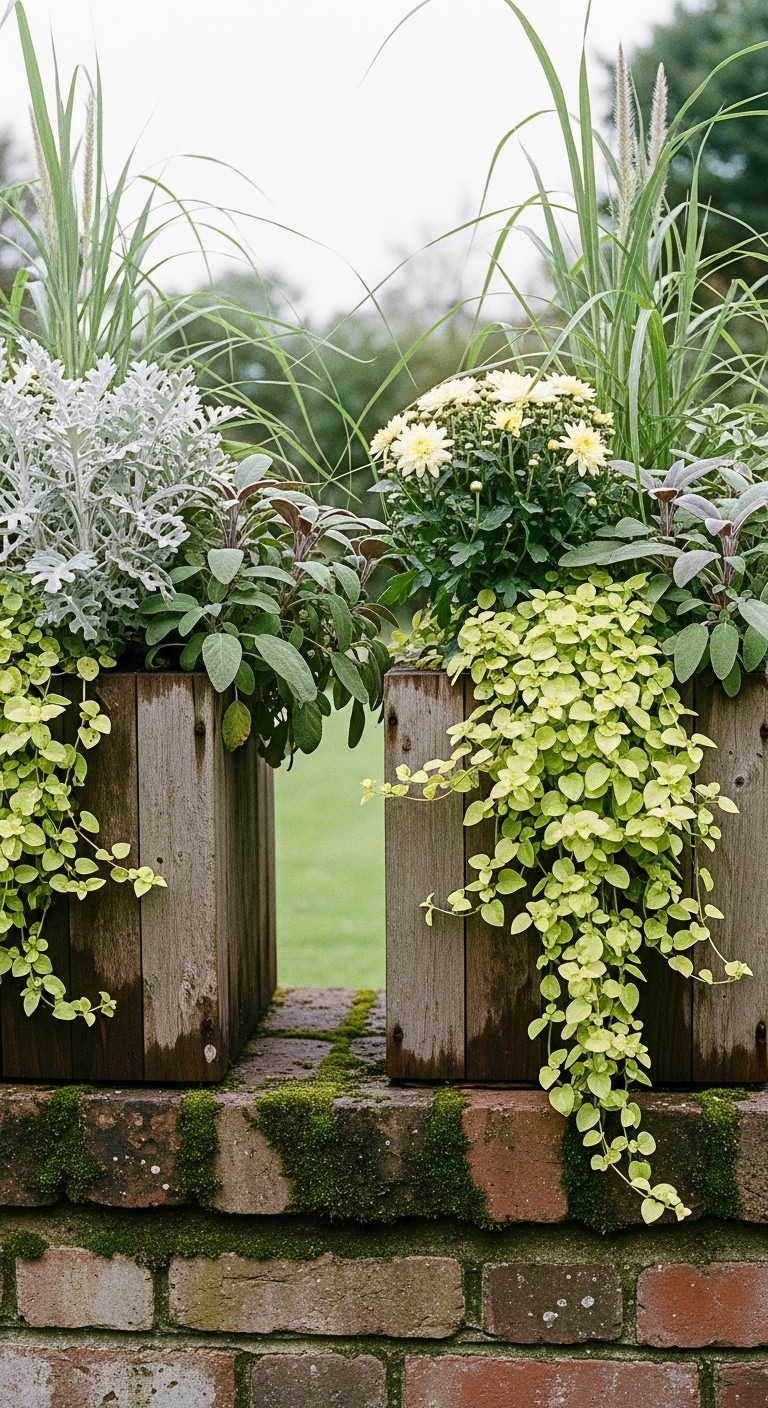
Palette 3: The Painter’s Palette
Who says vegetables can’t be stars? Swiss chard ‘Bright Lights’ makes an unexpected anchor. Its stems come in neon pink, orange, yellow—nature’s highlighter set. Purple fountain grass adds movement beside those bold stalks.
Create a fall combo planter with high impact. Mix flowering kale in shades from white to deep purple. Vibrant celosia adds texture like crushed velvet. Hot pink asters bring traditional fall flowers with a twist.
Variegated vinca minor trails down, its cream and green leaves echoing the chard’s veining.
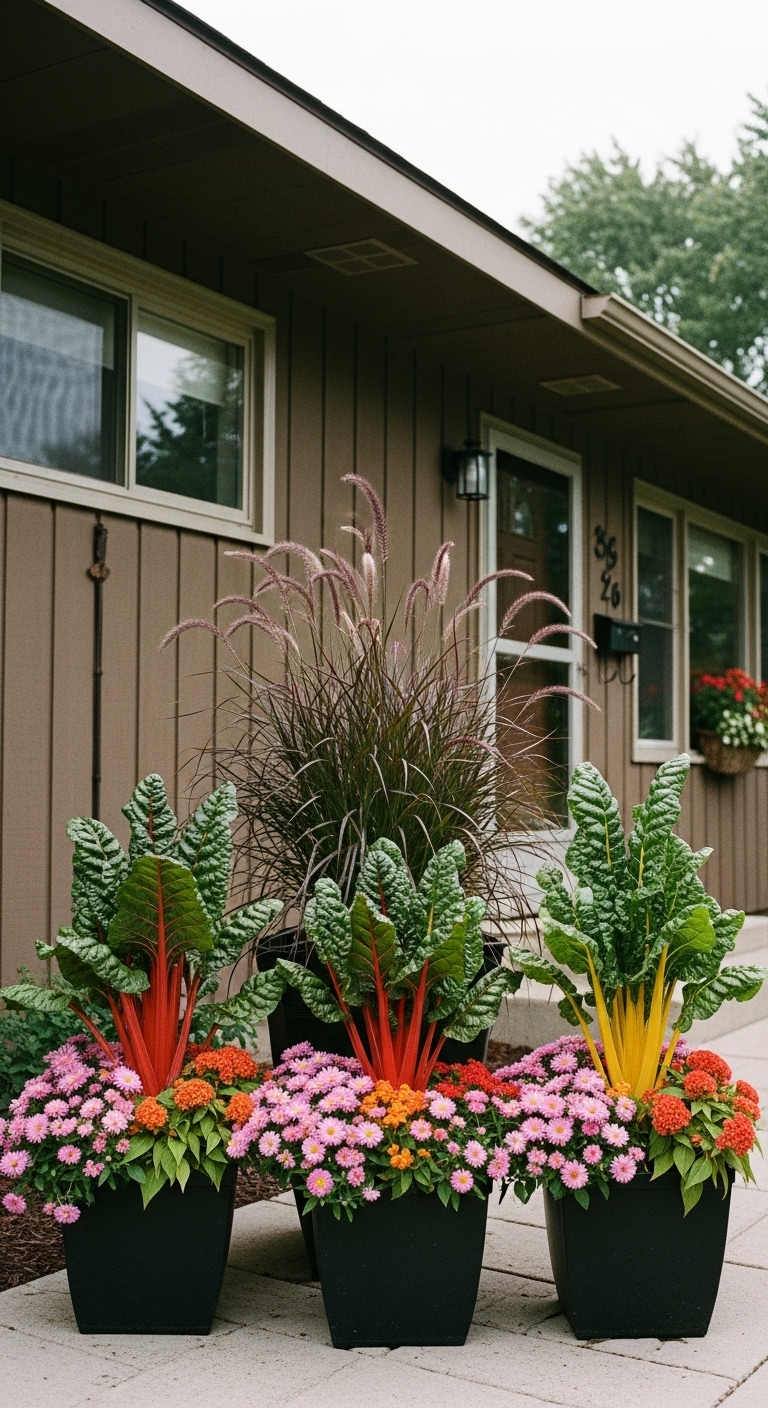
Beyond the Bloom: The Power of Unconventional Texture
Grasses and Sedges
Movement transforms static containers into living art. Japanese forest grass cascades like a green waterfall. Little bluestem grass turns copper-orange in fall. Sedges like Carex ‘Evergold’ bring year-round interest with minimal care.
Each grass variety offers something different. Some whisper in the breeze. Others stand rigid against winter winds. Mix heights and textures for maximum impact.
Seed Heads & Stems
Don’t deadhead everything. Spent echinacea creates architectural interest with dark cones. Sedum ‘Autumn Joy’ turns from pink to rust to brown—beautiful at every stage. Ornamental alliums leave behind perfect spheres that catch frost and snow.
These elements bridge seasons naturally. They’re gorgeous in October, striking in November, sculptural under December snow.
The Beauty of Bare Branches
Contorted willow branches spiral upward like nature’s calligraphy. Red-twig dogwood stems bring color when everything else fades. Harry Lauder’s walking stick creates wild curves against winter skies.
Cut branches last months in containers. They need no water, no care. Just pure structural interest.
Artificial Enhancements
Let’s be honest. Sometimes you need guaranteed color. Quality fall planters artificial elements can fill gaps tastefully. A few silk maple leaves tucked among real plants. One perfect artificial mum where live ones failed.
The key? Restraint. Use artificial elements as accents, not main features. Mix them thoroughly with live plants. Nobody will know your secret.
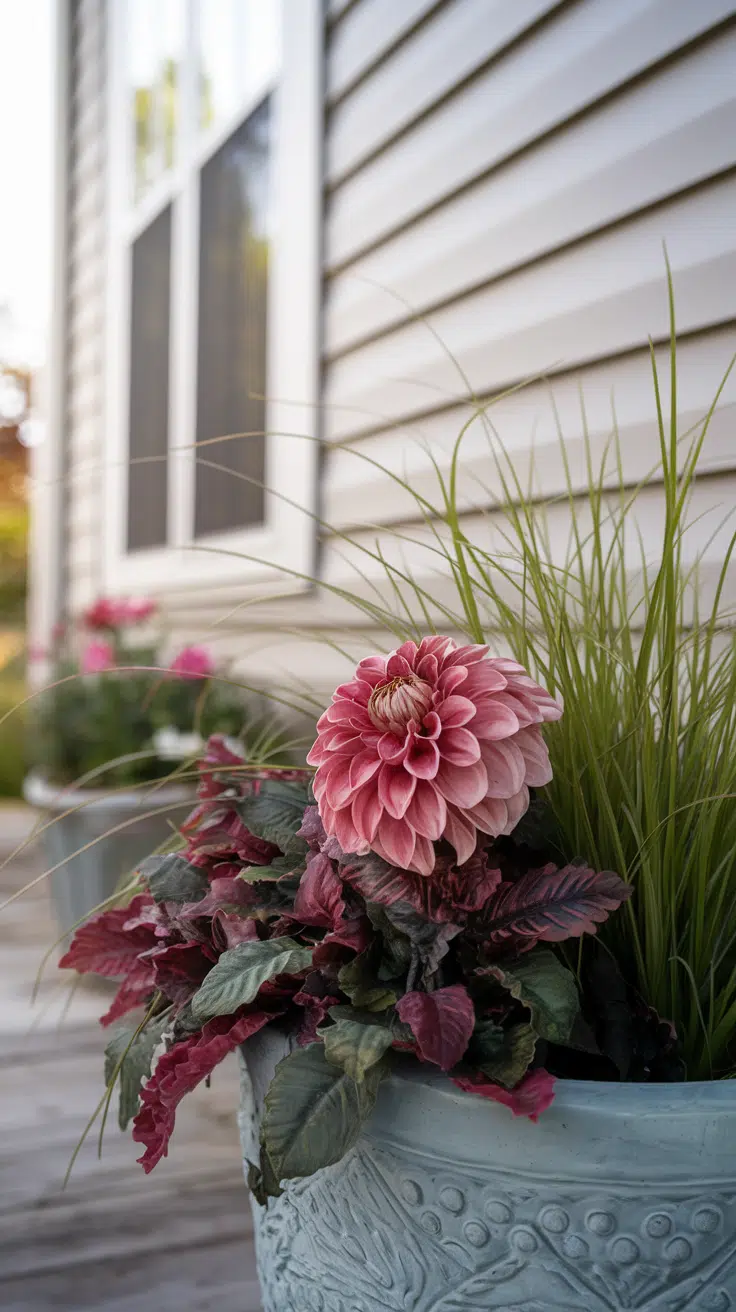
Smart Strategies: The Budget-Friendly & DIY Fall Planter
Forage Your Garden
Your yard holds treasures. Fall planters on a budget start with what you already grow.
Hostas might look tired in beds, but their leaves shine in containers. Cut them before frost and they’ll last weeks. Ornamental grass divisions cost nothing. Sedum cuttings root easily in container soil.
Walk your property with fresh eyes. That overgrown sage? Perfect for containers. Heuchera spreading too much? Divide and pot it up.
The “Pot-in-Pot” Method
Here’s a game-changer for cheap fall planters. Keep plants in their nursery pots. Sink them into larger containers filled with mulch or soil.
Swap plants easily as seasons change. No root disturbance. No transplant shock. Your outdoor fall planter stays fresh with minimal effort.
Focus on Foliage
Flowers fade fast in fall. But foliage? That’s your long-term investment. Ornamental kale costs the same as mums but lasts three times longer. Heuchera provides color from September through March.
One good foliage plant beats five mediocre flowers every time.
DIY Planter Boxes
Fall planters diy projects don’t require master carpentry skills. Four pieces of reclaimed wood. Some screws. Basic drainage holes. Done.
Cedar fence pickets make affordable planter sides. Old pallets break down into rustic boxes. Even concrete blocks stacked creatively become modern planters.
Line wooden planters with plastic for longevity. Add casters for easy moving. Paint them or leave them natural—both work.
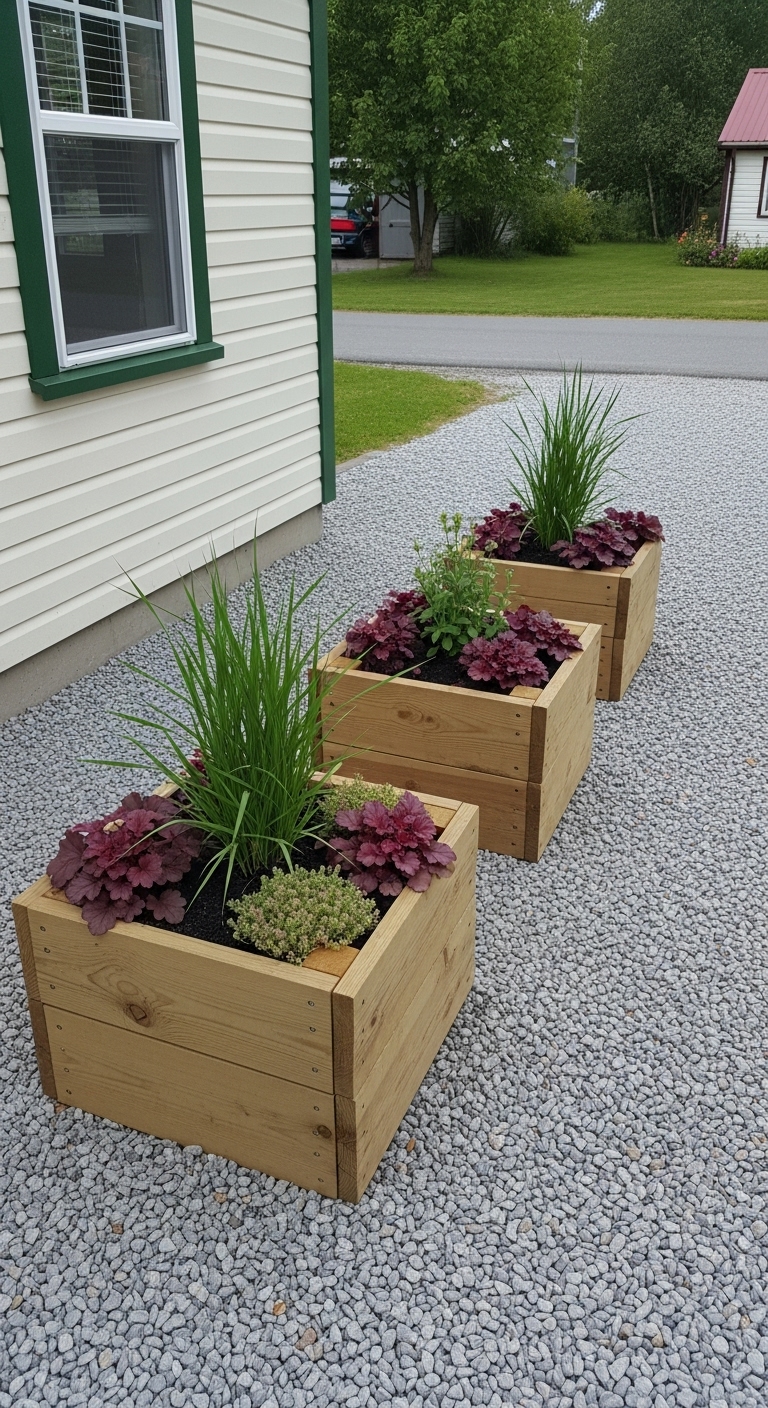
Assembly & Long-Term Care
Step-by-Step Planting Guide
Start with drainage. Even fall and winter containers need water to escape. Add two inches of gravel or broken pottery to your container bottom. Skip this step and watch roots rot by November.
Use quality potting mix, not garden soil. Garden soil compacts in containers, suffocating roots. Mix in slow-release fertilizer—your plants need food through their autumn show.
Plant your anchor first. Position it slightly off-center for visual interest. Firm soil around its roots. This plant carries your design, so give it solid foundation.
Add your weave plants next. Vary heights and angles. Don’t plant everything straight up. Tilt some plants outward. Let others lean toward the center. Nature doesn’t grow in perfect rows.
Finish with cascade plants around edges. Plant them at an angle, already spilling over. They’ll drape more naturally this way.
Water thoroughly until it runs from drainage holes. Soil settles after watering. Add more mix if needed. Your container should be full but not mounded.
Watering as Weather Cools
Fall watering tricks even experienced gardeners. Plants need less water as temperatures drop. But they still need some. Dry soil plus freezing temperatures equals dead roots.
Check containers weekly. Stick your finger two inches deep. Moist soil means wait. Dry soil means water. Simple.
Morning watering works best in fall. Plants absorb moisture before cold nights. Wet foliage at night invites disease.
Editing Your Planter
Some plants fade gracefully. Others look terrible. Know the difference and act accordingly.
Remove truly dead material. Brown mums? Pull them out. But leave ornamental grass plumes. Leave sedum heads. These elements add winter structure.
Fill empty spots with cut branches or small evergreen boughs. Pine, cedar, or juniper springs work perfectly. They’ll stay green through winter without roots.
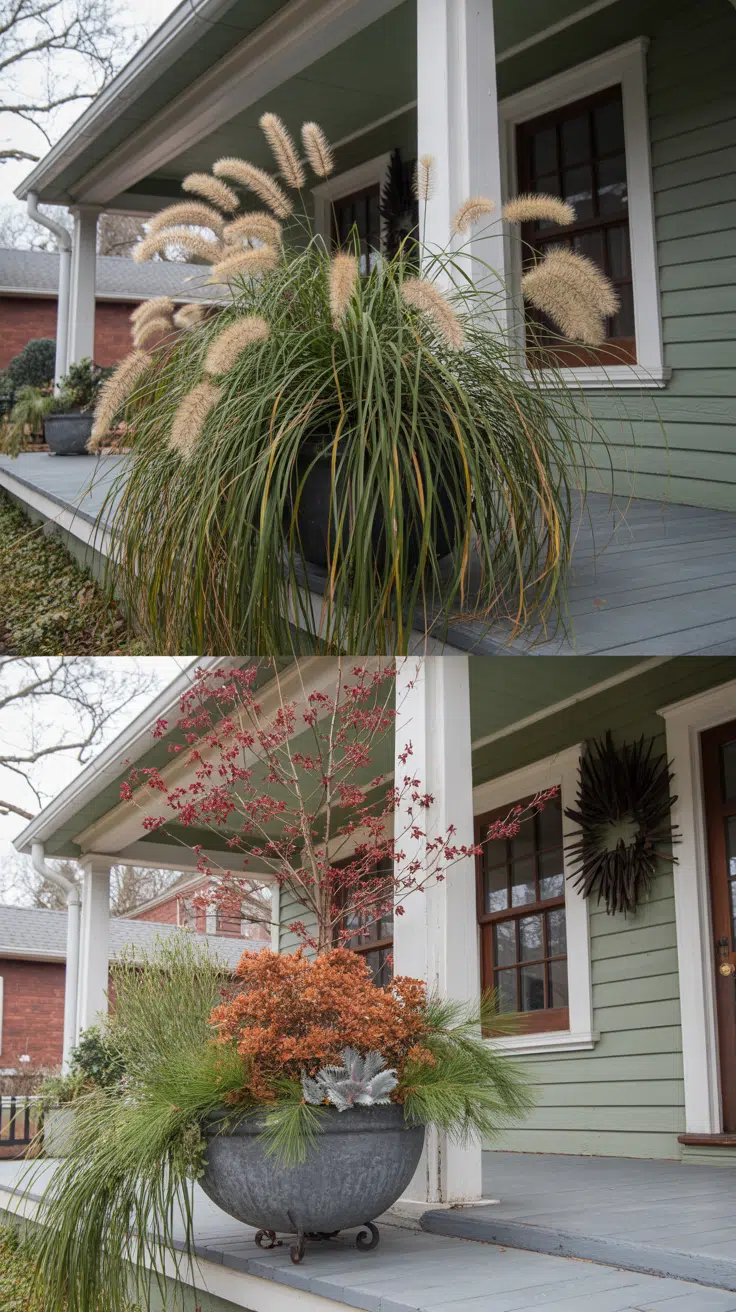
Your Autumnal Statement
You’ve learned to see beyond orange mums and mini pumpkins. Your fall planters can be so much more than seasonal clichés.
Remember the core principles. Structure beats spectacle every time. Texture creates interest when flowers fade. Plants that endure with grace carry your design through multiple seasons.
The tapestry method gives you a framework, not rigid rules. Anchors provide height and movement. Weave plants knit everything together. Cascading elements soften hard edges. But rules exist to be broken. Sometimes one perfect grass in a simple pot says everything.
Budget never needs to limit creativity. Your garden holds division possibilities. Thrift stores sell containers cheap. DIY planters from reclaimed wood cost almost nothing. Gorgeous fall planters come from imagination, not credit cards.
Most importantly, your containers should reflect your style. Love wild colors? Plant that Swiss chard and hot pink asters. Prefer subtle elegance? Silver and cream palettes await. Want low maintenance? Focus on grasses and evergreens.
Fall planters capture a fleeting season and hold it steady. They mark the transition between growth and rest. Between summer’s excess and winter’s simplicity.
Your entrance deserves more than tired decorations. Your fall planter boxes by a garage can transform forgotten spaces. Your porch containers can stop neighbors in their tracks.
So grab your gloves. Choose your containers. Select plants that speak to you.
Create something beautiful. Create something yours. Create your autumnal statement.
The season is waiting.

